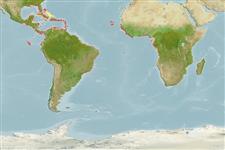Common names from other countries
Environment: milieu / climate zone / depth range / distribution range
Ecología
; salobre; rango de profundidad 0 - 2 m (Ref. 101599). Tropical; 33°N - 30°S, 98°W - 14°E
Distribución
Países | Áreas FAO | Ecosistemas | Ocurrencias, apariciones | Introducciones
Atlantic Ocean: from Florida to Bermuda, Mexico, Belize, Panama, the Antilles, Colombia, Venezuela, the Guianas, to Brazil (Para to Santa Catarina, including Fernando de Noronha), and the eastern Atlantic, from Senegal to Angola.
Length at first maturity / Tamaño / Peso / Age
Maturity: Lm 2.5, range 2 - 2.9 cm Max length : 5.6 cm CW macho / no sexado; (Ref. 102095); 5.1 cm CW (female)
Inhabits brackish muddy waters, often in mangrove swamps (Ref. 435), able to move fast between the roots and trunks of trees (Ref. 104080). Found in burrows (Ref. 86356), from intertidal to supratidal waters (Ref. 97531). Excellent predator in the mangroves (Ref. 104080). Feeds on mangrove propagules and animal matter (Ref. 86356). First marine crab reported to feed on an amphibian Leptodactylus macrosternum, wherein the frog was found near the crab's burrow (Ref. 104080).
Fischer, W., G. Bianchi and W.B. Scott (eds.). 1981. (Ref. 435)
IUCN Red List Status (Ref. 130435)
CITES status (Ref. 108899)
Not Evaluated
Not Evaluated
Human uses
Pesquerías: comercial
| FishSource |
Herramientas
Fuentes de Internet
Estimates based on models
Preferred temperature
(Ref.
115969): 25.2 - 28.1, mean 27.4 (based on 644 cells).
Resiliencia
Alto, población duplicada en un tiempo mínimo inferior a 15 meses (K=2.24-2.5; tm=0.23).
Vulnerability
Low vulnerability (10 of 100).
Price category
Unknown.
